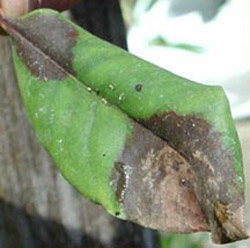Issue 1, April 16, 2010
Sudden Oak Death Update
Sudden oak death is a disease that kills oaks. It is present in California, Oregon, and Washington. The cause is a fungal-like pathogen, Phytophthora ramorum. The disease appeared in California in 1995. The last time I discussed Sudden Oak Death in this newsletter was April 15, 2008. Review that issue for details about this exotic invasive disease.
The main concern now is that Ramorum blight (also known as sudden oak death, ramorum leaf blight, and ramorum dieback) might spread to Midwestern and Eastern U.S. forests, killing oak stands. It will likely arrive on one of many shrub hosts. The disease has not been found in Illinois. It first started popping up in Eastern U.S. nurseries in 2004, on material shipped from the west coast. For that reason, state and federal inspectors became involved in quarantines and inspections for this disease. The disease was identified in an Indiana nursery in 2006 and was quickly identified and eradicated. That is the closest find to our state.
In April of 2010 (earlier this month), Phytophthora ramorum was confirmed from bay laurel seedlings at a commercial greenhouse in Pennsylvania. This time the source of infection has not been established. The pathogen has been controlled and did not enter the forestry environment. As with any such discovery, inspectors conduct investigations to trace possible shipments both into and out of the nursery. Labs such as the University of Illinois Plant Clinic and others in the NPDN (National Plant Diagnostic Network) are utilized to test suspect plant material.
The US Department of Agriculture Animal and Plant Health Inspection Service (APHIS) monitors thousands of nursery surveys for this pathogen each year via cooperative programs with states. The University of Illinois Plant Clinic tested samples collected by the Illinois Department of Agriculture and Illinois APHIS inspectors in 2004, 2005, and 2006. Last year (2009) we performed enzyme linked immunosorbant assays (ELISAs) on 145 nursery samples. Nineteen of these had PCR follow-up testing, provided by the Michigan State University clinic. None contained Phytophthora ramorum. The pathogen has not been found in Illinois.
Here is a link with more information on Phytophthora ramorum. As of February 2010, there are 45 proven hosts regulated for Phytophthora ramorum. There are also 82 plants associated with Phytophthora ramorum. The current list of hosts can be found on the USDA APHIS web site.

If you purchase plants from the west coast, find out whether they may carry this pathogen. Start by reviewing the host list referenced above. Then become familiar with the symptoms that might appear on your plants. The image is borrowed from the California Mortality Task Force web site. The infected rhododendron leaves show leaf spots with diffuse margins, water-soaked appearance, and identical symptoms on the top and bottom of leaves. The resources listed above provide many images. Finally, if you have a plant that appears symptomatic and originated on the west coast in the last 1 to 3 years, talk to your nearest diagnostic lab for instructions on how to send a sample for testing.--Nancy Pataky
Author:
Nancy Pataky